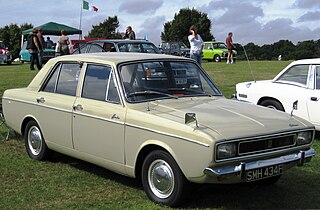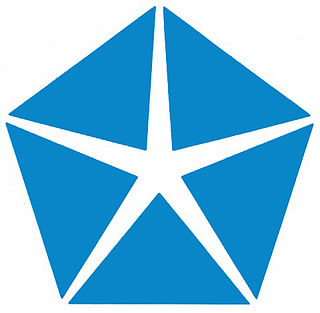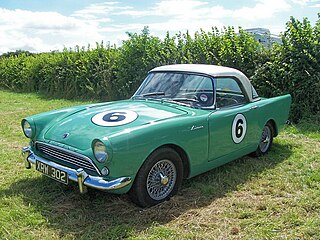
The Mini is a small economy car produced by the English-based British Motor Corporation (BMC) and its successors from 1959 until 2000. The original is considered an icon of 1960s British popular culture. Its space-saving transverse engine, front-wheel drive layout – allowing 80% of the area of the car's floorpan to be used for passengers and luggage – influenced a generation of car makers. In 1999, the Mini was voted the second-most influential car of the 20th century, behind the Ford Model T, and ahead of the Citroën DS and Volkswagen Beetle.

The Rootes Group or Rootes Motors Limited was a British automobile manufacturer and, separately a major motor distributors and dealers business. Run from London's West End, they were respectively based in the Midlands and south of England. In the decade beginning 1928 the Rootes brothers, William and Reginald, made prosperous by their very successful distribution and servicing business, were keen to enter manufacturing for closer control of the products they were selling. One brother has been termed the power unit, the other the steering and braking system.

Rootes Arrow was the manufacturer's name for a range of cars produced under several badge-engineered marques by the Rootes Group from 1966 to 1979. It is amongst the last Rootes designs, developed with no influence from future owner Chrysler. The range is almost always referred to by the name of the most prolific model, the Hillman Hunter.

Commer was a British manufacturer of commercial vehicles from 1905 until 1979. Commer vehicles included car-derived vans, light vans, medium to heavy commercial trucks, military vehicles and buses. The company also designed and built some of its own diesel engines for its heavy commercial vehicles.

The Hillman Avenger is a rear-wheel drive small family car originally manufactured by the former Rootes division of Chrysler Europe from 1970–1978, badged from 1976 onward as the Chrysler Avenger. Between 1979 and 1981 it was manufactured by PSA Peugeot Citroën and badged as the Talbot Avenger. The Avenger was marketed in North America as the Plymouth Cricket.
Economy car is a term mostly used in the United States for cars designed for low-cost purchase and operation. Typical economy cars are small, lightweight, and inexpensive to buy. Economy car designers are forced by stringent design constraints to be inventive. Many innovations in automobile design were originally developed for economy cars, such as the Ford Model T and the Austin Mini. The alternative approach, other than innovating to build a low-cost car, is to build a stripped-down, no-frills version of a conventional car.

Chrysler Europe was the American automotive company Chrysler's operations in Europe from 1967 through 1979. It was formed from the merger of the French Simca, British Rootes and Spanish Barreiros companies. In 1979, Chrysler divested these operations to PSA Peugeot Citroën.

The Chrysler Sunbeam is a small supermini three-door hatchback manufactured by Chrysler Europe at the former Rootes Group factory in Linwood in Scotland from 1977 to 1981. The Sunbeam's development was funded by a British government grant with the aim of keeping the Linwood plant running, and the small car was based on the larger Hillman Avenger, also manufactured there. After the takeover of Chrysler's European operations by PSA, the model was renamed "Talbot Sunbeam" and continued in production until 1981. A Talbot Sunbeam Lotus version was successful in rallying and won the World Rally Championship manufacturers' title for Talbot in 1981.

Humber Limited was a British manufacturer of bicycles, motorcycles and motor vehicles incorporated and listed on the stock exchange in 1887. It took the name Humber & Co Limited because of the high reputation of the products of one of the constituent businesses that had belonged to Thomas Humber. A financial reconstruction in 1899 transferred its business to Humber Limited.

The Hillman Husky was a line of British passenger vehicles manufactured between 1954 and 1970 by Hillman.

The Mini Moke is a vehicle based on the Mini designed for the British Motor Corporation (BMC) by Sir Alec Issigonis and John Sheppard.

The Clan Crusader is a fibreglass monocoque British sports car based on running gear from the Hillman Imp Sport, including its Coventry Climax derived, rear-mounted 875 cc engine. It was first made in Washington, Co Durham, England between 1971 and 1974, but since then several efforts have been made to bring the car back to production. Plans were made by Martin Phaff to re-resurrect the Clan in 2009, but nothing seems to have come of the project so far.
The Concept Centaur GT was a kit car first built by Concept Cars Ltd of Middleton, Leicestershire, in 1973 and marketed from 1974 to 1977. The design was very much influenced by the Probe 15 from Adams Probe Motor. The car is famous for possibly being the lowest car ever made being only 94 cm (37 in) high. It was based on the Hillman Imp mechanicals and the body was a GRP-and-plywood monocoque with box section and steel tube reinforcement. The number of models produced is disputed, both 26 and 52 cars have been quoted.
Davrian cars were built by Davrian Developments at 65 North Street, Clapham in London, England, from 1965 to 1976, in Tregaron, Dyfed, Wales from 1976 to 1980 and Lampeter, Dyfed, from 1980 to 1983.

William Bernard Unett was a British racing driver and development engineer, three times winner of the British Touring Car Championship in 1974, 1976 and 1977.
British Motor Corporation (Australia) was a motor manufacturing company formed in Australia in 1954 by the merger of the Austin Motor Company (Australia) and Nuffield (Australia) Pty Ltd. This followed the merger in 1952 of the Austin Motor Company and the Nuffield Group in the United Kingdom to form the British Motor Corporation. Following further corporate changes in the UK in the late 1960s, BMC Australia was absorbed into the newly established British Leyland Motor Corporation of Australia, the name of which became Leyland Motor Corporation of Australia in 1972, and then JRA Limited in March 1983.

The Commer FC was a commercial vehicle produced by Commer from 1960 to 1976. During its lifespan, it was developed into the Commer PB in 1967, and the Commer SpaceVan in 1974. After the Rootes Group, which owned Commer, was purchased by Chrysler, the SpaceVan was also sold under the Dodge and Fargo marques. From 1976 onwards, the van was only sold as the Dodge SpaceVan, and it remained in production until 1983.

The Siva Motor Car Company was a British manufacturer of automobiles active from 1970 to 1976.















